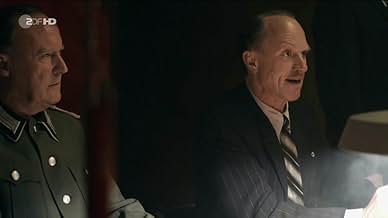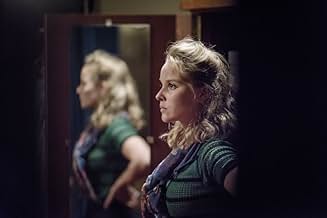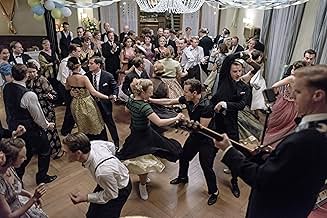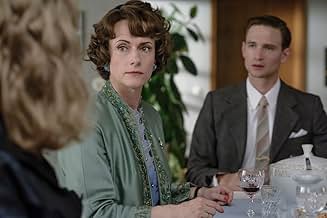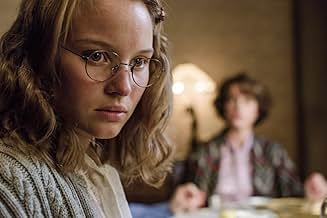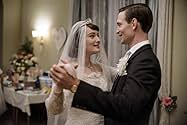Ku'damm 56
- Miniserie de TV
- 2016
- 1h 40min
PUNTUACIÓN EN IMDb
7,6/10
2,5 mil
TU PUNTUACIÓN
Añade un argumento en tu idiomaGenerations clash when the feisty daughter of a dance studio owner defies her mother's wishes and embraces the fight for gender equality in 1950s Berlin.Generations clash when the feisty daughter of a dance studio owner defies her mother's wishes and embraces the fight for gender equality in 1950s Berlin.Generations clash when the feisty daughter of a dance studio owner defies her mother's wishes and embraces the fight for gender equality in 1950s Berlin.
- Premios
- 5 premios y 13 nominaciones en total
Explorar episodios
Argumento
¿Sabías que...?
- Versiones alternativasConsists of three approximately 90 minute episodes, however in certain countries, such as France, was instead presented as six approximately 45 minute episodes. There is no difference in terms of content.
- ConexionesFollowed by Ku'damm 59 (2018)
Reseña destacada
Looking back in historical perspective 1956 was one of these turning point years in history, when things accelerate, when a lot of related and unrelated events with lasting consequences happen. It was the first such year after WWII, the year of the Khrushchev report that started the de-stalinization process in the Soviet Union, the year of the Hungarian anti-communist revolt in Hungary crushed by the same Soviet Union, the year of the Suez war. While less spectacular things happened in occupied Berlin and Germany, 1956 was a typical year in the middle of the decade that saw Germany recovering from an economic point, while part of its population tried to put the past behind them. Forgetting the past would not work, we know it know, and Germany really recovered only after assuming its past morally and historically, but this was a process that last many years. 1956 was somehow in the middle, and the transition to peace and prosperity was felt and lived differently by different categories of people, by those who were to young to remember, by those who wanted the past forgotten, and by those who could not forget - the survivors of the camps, the former prisoners. Add to all these the occupation and division of Germany and of the city of Berlin (not completed at that time, the Berlin wall was built only in 1961) and the clash of cultures initiated by the beat and rock generation which took specific aspects in Germany. It was a complex landscape, which forms the background for the TV mini-series Ku'damm 56 which was screened on the French version of ARTE TV as 'Berlin 56'.
The Kurfürstendamm or Ku'damm as Berliners and especially visitors call it, the main commercial street of West Berlin, hosts in the movie the school of dance of Caterina Schöllack (Claudia Michelsen) whose husband did not return from the war, leaving her with the task of raising her three daughters. From many respects she is a symbol of the old Germany, doing her best to survive and adapt, to forget the past and build the future of her daughters the way she believes is best - marrying them well as good German wives into rich families, or at least with solid honorable husbands. This seems to work with the two elder daughters, but not with Monika, the younger one (Sonja Gerhardt) who is different from her sisters from all points of view - a mix of rebel and non-adapted character, with one big passion - dancing. She actually has inherited this skill from her mother, but the tastes are different in a world where jazz and 'decadent' rock'n'roll become in Germany as all over the world a symbol of generations clash. The story describes well the evolution of the four women, their relationships, their rebellion and compromises on the social and political background of a country where ruins were not completely cleaned up and wounds of the recent past were still bleeding for many.
Quite different, and actually the opposite of the situation in many scripts of the big or TV screens, while the four women profiles are well built and developed, some of the men characters are reduced to stereotypes. When they are not schematic their evolution is problematic - like the character of Joachim Franck and the troubled relationship to Monika, which starts with a rape to become almost a failed love story. It also seemed to me that the East Berlin scenes lacked a more serious perspective of the differences between the two parts of the Germany. There is a lot of dance and music and the differences in style between the different genres occupy an important role in the series, these could be the subject of another film, or maybe of the continuation of the series, as 1956 is also the point in history when Berlin starts recovering its between-wars shining as a multi-cultural center. As the ending shows Monika walking a Ku'dam that looks like a Dorothy from Oz path to new horizons, the continuation of the series may be in preparation. I am looking forward to it.
The Kurfürstendamm or Ku'damm as Berliners and especially visitors call it, the main commercial street of West Berlin, hosts in the movie the school of dance of Caterina Schöllack (Claudia Michelsen) whose husband did not return from the war, leaving her with the task of raising her three daughters. From many respects she is a symbol of the old Germany, doing her best to survive and adapt, to forget the past and build the future of her daughters the way she believes is best - marrying them well as good German wives into rich families, or at least with solid honorable husbands. This seems to work with the two elder daughters, but not with Monika, the younger one (Sonja Gerhardt) who is different from her sisters from all points of view - a mix of rebel and non-adapted character, with one big passion - dancing. She actually has inherited this skill from her mother, but the tastes are different in a world where jazz and 'decadent' rock'n'roll become in Germany as all over the world a symbol of generations clash. The story describes well the evolution of the four women, their relationships, their rebellion and compromises on the social and political background of a country where ruins were not completely cleaned up and wounds of the recent past were still bleeding for many.
Quite different, and actually the opposite of the situation in many scripts of the big or TV screens, while the four women profiles are well built and developed, some of the men characters are reduced to stereotypes. When they are not schematic their evolution is problematic - like the character of Joachim Franck and the troubled relationship to Monika, which starts with a rape to become almost a failed love story. It also seemed to me that the East Berlin scenes lacked a more serious perspective of the differences between the two parts of the Germany. There is a lot of dance and music and the differences in style between the different genres occupy an important role in the series, these could be the subject of another film, or maybe of the continuation of the series, as 1956 is also the point in history when Berlin starts recovering its between-wars shining as a multi-cultural center. As the ending shows Monika walking a Ku'dam that looks like a Dorothy from Oz path to new horizons, the continuation of the series may be in preparation. I am looking forward to it.
- dromasca
- 14 abr 2017
- Enlace permanente
Selecciones populares
Inicia sesión para calificar y añadir a tu lista para recibir recomendaciones personalizadas
- How many seasons does Ku'damm 56 have?Con tecnología de Alexa
Detalles
- Duración1 hora 40 minutos
- Color
Contribuir a esta página
Sugerir un cambio o añadir el contenido que falta

Principal laguna de datos
By what name was Ku'damm 56 (2016) officially released in Canada in English?
Responde

